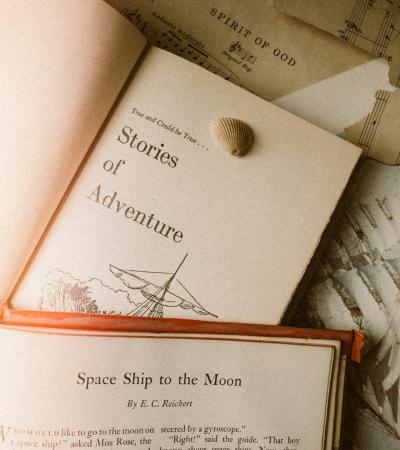Recently, Nancy Opalko, a children’s librarian at a public library who has paired with a local alternative school for the Great Stories CLUB, asked the program’s electronic discussion list two good questions: “How can I promote more interest in the book and get a discussion going?” and “How do the rest of you handle disruptive behavior?” Her questions immediately got a number of responses, many of which can be adapted and expanded beyond the Great Stories CLUB to work in your library.

Virginia Bigler, a librarian at Pease Middle School, suggested starting a “Big Sister-Little Sister Reading Club”:
I chose eleven female teachers who are avid readers and asked if they wanted to participate. I gave each a copy of each of the three books. They read the books themselves, then adopted a “little sister.” They wrote an inscription inside the front cover, then gave the books to the little sister to read.
This could translate well in your library, perhaps with staff members acting as Big Sisters, or how about involving your teen advisory group to work with younger readers?
Virginia also suggested enhancing the discussion through social networking:
I set up a blog, and the teachers and their little sisters are sharing ideas on the blog. We also had a really nice breakfast in the library to kick off the reading club, show the girls how to blog, and get to know one another. After everyone’s had a chance to finish and post their comments, we’ll get together in the library for breakfast again. Check out the blog at http://libblog.nisd.net/046vbigler/.
Charlotte Edman Abelson, an English teacher at Whiting High School, and Donna Reed, an English teacher at a rural alternative high school, also use blogs with their groups. Charlotte noted, “They’re required to blog about the book at least three times a week (for a grade), but that isn’t something difficult to enforce—they’ve enjoyed blogging.” She also asked, “I’d like to try something with texting—does anyone have a thought on that?” [Editor’s note: If you do, feel free to add it below in the comments]]
In addition, Rachelle Wynkoop, a school media specialist at Algonac High, recommended “a social networking site for booklovers called Shelfari”:
Students can create profiles similar to Facebook or Myspace, including a virtual bookshelf. You can create a private discussion group with your book club. We have done this for the book club we started lasted year before we became involved in Great Stories and it has been successful.
Discussion list members offered a number of suggestions for keeping discussion group members engaged. Robin Shoup, a librarian at Maricopa High School, noted that:
Connecting to the readers’ lives and building background are important. It makes the story “real” to the readers. Try drawing an important scene, an event, etc. and have them write one sentence explaining it. Prereading activities (discussion, building context, connecting, vocabulary) are key to building interest and having success with the story. Spend a couple of sessions on that prior to reading the next book. (This is the former Language Arts teacher talking).
Donna Reed gave some tips she uses with her groups:
We did a few prereading activities before starting The Afterlife [one of the Great Stories CLUB books]. We read a Soto short story, and some poetry, talked about Latino culture in our town. Some days we read on our own, some days we read together. I agree that it’s difficult to keep everyone reading at the same pace when we read individually, but we agree on how far is reasonable to read until we discuss again. Of course, not everyone is there, so I ask a student to review and update for the group. I’m sympathetic, though, because I don’t always finish the book I’m reading in my own book group!
I keep a note pad and ink pens at everyone’s seat. Once or twice during each book club meeting, I will ask a question where they need to write their response on the notepad and put it into a basket. No names are given. Some of the questions might be: If you were a ghost, who would you go see and why? What are some destructive ways you have seen other teens deal with pressure or stress? What are some positive ways you can use when dealing with stress?
Most kids want to participate as long as it is anonymous and no pressure. Plus it gives me a chance to gage the group’s thinking.
Jane C. Routte, lead teacher/reading coach at Marion Juvenile Correctional Facility, offered:
I work with alternative students (incarcerated boys), and I have found that some students like to read to each other in small groups of 3 or 4, and then call the groups together to discuss what they have read after 20–25 minutes. The students like to out-do each other with finding ideas and details that other groups miss. I have found that my students would rather read than be read to.
Another thing they like is to have a student read a section, then have students name one detail that they remember from the reading. Go around the room and have each student name one thing with no repeats. They really start to pay attention if you keep track of their responses and reward them with a treat at the end.
Darby Wallace offered a suggestion for one of the Great Stories CLUB books, The Rules of Survival, that would work well with current events: “On a more serious note, ask them [the book group members] to imagine what kids in Haiti would list as their rules right now.”
A few discussion list members had suggestions for keeping the group running smoothly. Jane C. Routte, lead teacher/reading coach at Marion Juvenile Correctional Facility, said to:
Make sure that the group establishes respect norms at the beginning of the session. Each student should show respect for the person reading, and for the group as a whole. Most students will abide by those norms. Just make sure to reward the positive participants with compliments and praise.
Robin Shoup recommended that discussion group leaders “[t]alk with their English or Social Studies teacher. What insights can they give you on how to motivate or handle disruptive behavior?”
Finally, Ellie Seemann, school librarian at Horizons Alternative High School, noted that she worked with “many students who come from lower socio-economic backgrounds” and offered some resources for working with that population:
Two of Ruby Payne’s books have been invaluable to me in understanding who they are and the best approach to take when serving them:
• A Framework for Understanding Poverty
• Under-Resourced Learners: 8 Strategies to Boost Student Achievement
The well-researched books distinguish characteristics of students living in poverty from those of upper or middle class homes. They discuss everything from patterns of speech and survival skills, to how to form relationships and effectively discipline. If you are trying to find the right approach to working with teens who have had a rough start in life, these may hold some eye-opening insights for you. They explain a lot, and suggest practical techniques.
How would you use these ideas on your library? Share in the comments below!



